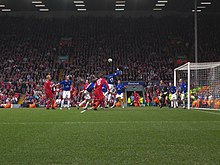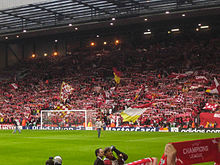Colours and crest
| Liverpool's original home colours (1892–1894) |
Shankly wanted his players to be more distinctly dressed, he decided to update the kit, changing the white sorts and socks to red. Liverpool played in all red for the first time against Anderlecht, as Ian St. John recalled in his autobiography:
1991–92 centenary season, when it was replaced by a combination of green shirts and white shorts. After various colour combinations in the 1990s, including gold and navy, bright yellow, black and grey, and ecru, the club alternated between yellow and white away kits until the 2008–09 season, when the grey kit was re-introduced. The club's third kit is designed for European away matches, though on occasions when the current away kit clashes with a team's home kit in domestic matches, the kit would be worn. The current kits are designed by Adidas, who made the club's kits between 1985 and 1996. The only other branded shirts worn by the club was made by Umbro until 1985 and Reebok for ten seasons starting in 1996.
Liverpool was the first English professional club to have a sponsor's logo on their shirts, after they agreed to a deal with Hitachi in 1979. Since then the club has been sponsored by Crown Paints, Candy, Carlsberg and Standard Chartered Bank. The contract with Carlsberg, which was signed in 1992, was the longest agreement in English top-flight football. The association with Carlsberg was ended at the start of the 2010–11 season with Standard Chartered Bank becoming the club's sponsor.
The Liverpool badge is based on the city's liver bird, which is placed inside a shield. Above the shield is a representation of the Shankly Gates with the title of club's famous anthem, "You'll Never Walk Alone". The twin flames at either side are symbolic of the Hillsborough memorial outside Anfield, where an eternal flame burns in memory of those who died in the disaster.
Stadia
For more details on this topic, see Anfield.
For information on Liverpool's proposed new stadium, see Stanley Park Stadium.

Anfield, home of Liverpool
In 1906, the banked stand at one end of the ground was formally renamed the Spion Kop after a hill in Natal. The hill was the site of the Battle of Spion Kop in the Second Boer War, where over 300 men of the Lancashire Regiment died, many of whom were from Liverpool. At its peak, the stand could hold 28,000 spectators, and was one of the largest single tier stands in the world. Many stadia in England had stands named after the Spion Kop, but Anfield's was the largest Kop in the country at the time; it was able to hold more supporters than some entire football grounds.
Anfield could hold over 60,000 supporters at its peak, and had a capacity of 55,000 until the 1990s. The Taylor Report and Premier League regulations obliged Liverpool to convert Anfield to an all-seater stadium in time for the 1993–94 season, thus reducing the capacity to 45,276. The findings of the Taylor Report precipitated the redevelopment of the Kemlyn Road Stand. The stand was rebuilt in 1992, coinciding with the centenary of the club and is now known as the Centenary Stand. An extra tier was added to the Anfield Road end in 1998, which increased the capacity of the ground further, though the stand encountered problems upon opening. A series of support poles and stanchions were inserted to give extra stability to the top tier of the stand after movement of the tier was reported at the start of the 1999–2000 season.
Due to the restrictions of expanding the capacity at Anfield, Liverpool announced plans to move a new stadium at Stanley Park in May 2002. Planning permission was granted in July 2004, and in September 2006, Liverpool City Council agreed to grant Liverpool a 999-year lease of the land on the proposed site. Following the takeover of the club in February 2007 by George Gillett and Tom Hicks, the proposed stadium was redesigned. In November 2007, the new design was approved by the Council, and preparation of the site started in June 2008, with HKS, Inc. contracted to build the stadium. Construction of the stadium was halted in May 2008, as Gillett and Hicks had trouble financing the £300 million needed for the development.
New England Sports Ventures, who purchased the club on 15 October 2010, are evaluating the possibility of drastically refurbishing Anfield against building a new stadium.
Supporters
During the 2009–10 season, Liverpool had the fourth-highest average League attendance for an English club: 44,392, which is 94.4% of available capacity. Liverpool fans often refer to themselves as "Kopites", which is a reference to the fans who once stood, and now sit, on the Kop at Anfield. In 2008, a group of fans decided to form a splinter club, A.F.C. Liverpool, the club was set up to provide a match-going experience for fans who had been priced out of watching Premier League football.The song "You'll Never Walk Alone", originally from the Rodgers and Hammerstein musical Carousel and later recorded by Liverpool musicians Gerry & The Pacemakers, is the club's anthem, and has been sung by the Anfield crowd since the early 1960s. It has since gained popularity among fans of other clubs around the world. The song's title adorns the top of the Shankly Gates, which were unveiled on 2 August 1982 in memory of the former manager Bill Shankly. The "You'll Never Walk Alone" portion of the Shankly Gates is also reproduced on the club's crest.

The Shankly Gates erected in honour of former manager Bill Shankly.
The second was during an FA Cup semi-final between Liverpool and Nottingham Forest at Hillsborough Stadium, Sheffield on 15 April 1989. 96 Liverpool fans died due to overcrowding in the Leppings Lane End, in what became known as the Hillsborough disaster. The Sun newspaper published an article entitled "The Truth", in which it claimed that Liverpool fans had robbed and urinated on the dead and had attacked the police. Subsequent investigations proved the allegations to be false, and this led to a city-wide boycott of the newspaper. Many organisations were set up as a result of the disaster, such as the Hillsborough Justice Campaign, which represents bereaved families, survivors and supporters in their efforts to secure justice.
Rivalries
Main articles: Merseyside Derby and Liverpool F.C. and Manchester United F.C. rivalry

Merseyside derby at Anfield in 2006
Liverpool has a rivalry with Manchester United. The rivalry is viewed as a manifestation of the cities' competition during industrial times, when they competed for supremacy of the north-west; Liverpool was considered the world's pre-eminent port, while Manchester was famous for its textile industry. The rivalry between the clubs intensified from the 1960s onwards. In 1968, Manchester United became the first English team to win the European Cup, their achievement would soon be eclipsed by Liverpool who won four European Cups during the 1970s and 80s. Then in the 1990s Manchester United started to dominate English football making the rivalry all the more intense. The rivalry is so intense that the last player to be transferred between the two clubs was Phil Chisnall in 1964, when he moved to Liverpool from Manchester United.



0 comments:
Post a Comment